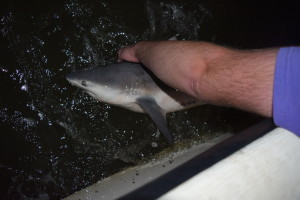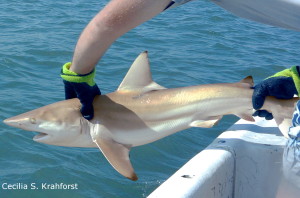by Heather Soulen
Last year marked the 40th anniversary of the movie Jaws, regarded by many as “the movie that changed Hollywood.” While true, Jaws shaped more than just Hollywood. With its ominous, adrenaline pumping two-note score and imagery of a bloodthirsty, torpedo-shaped predator with rows of razor-sharp teeth, Spielberg’s film shaped our perception of sharks.

The team’s first tagged juvenile bull shark (Photo credit: Kim Richie)
After Jaws, fear of the unknown arrested us, and our lack of knowledge helped demonize sharks. But the winds are shifting. New research initiated by the Smithsonian Environmental Research Center’s Fish and Invertebrate Ecology Lab aims to investigate habitat use, migration patterns, and species interactions of four underrepresented shark species found in the Chesapeake Bay and along the Atlantic Coast.
The Atlantic Coast is one of the global hotspots for shark biodiversity, and with biodiversity being a vital component of healthy and productive ecosystems, this kind of research is long overdue.
“Sharks are a lot like wolves in Yellowstone National Park or lions in the Serengeti. They can be indicators of healthy ecosystems because they’re likely to be found in places that support large numbers of prey species,” said Matt Ogburn, the lab’s principal investigator.
Ogburn, post-doctoral fellow Chuck Bangley and their colleagues plan to catch and tag four species of sharks found in the Chesapeake Bay and along the Atlantic Coast: smooth dogfish (Mustelus canis), blacktip sharks (Carcharhinus limbatus), dusky sharks (Carcharhinus obscurus), and bull sharks (Carcharhinus leucas).
“Right now there’s a very broad idea that certain sharks are here in the summer, certain sharks are here in the winter,” Bangley said. “But nobody’s really defined what temperature range they like, what salinity range they like, are they following certain species of prey, things like that.”
Their toughest challenge will be spending enough time on the water to find, catch and tag 80 sharks, 20 of each species. To get that water time, the team joined forces with the Virginia Institute of Marine Science’s (VIMS) Shark Monitoring and Assessment Program and North East Area Monitoring and Assessment Program, East Carolina University, and Florida Atlantic University’s Harbor Branch Oceanographic Institute, with other partners expected to join in summer 2017. They began searching for sharks in late summer 2016. As of January 2017, the team has already tagged six sharks, and tagging will continue through 2017 to reach the their goals.

Tagged blacktip shark returning to the water (Photo credit: Cecilia Krahforst)
The majority of the sharks will be tagged with a special acoustic tag that taps into the Atlantic Cooperative Telemetry Network, a network of scientist-maintained acoustic receivers located along the Atlantic Coast. Whenever a tagged organism comes within about a half mile or less of a receiver, it transmits a signal to the receiver and a record for the location, tag number, date and time is logged. Ogburn and his team have already participated in the network through their cownose ray and invasive blue catfish studies.
While the information the receivers collect is useful, it’s restricted to the stationary location of that receiver. To understand more “day in the life” shark behavior, the team plans to outfit a few sharks with satellite tags that beam up location information when a shark surfaces anywhere in the world for 90 seconds or longer. Some satellite tags on the market can log temperature, salinity, and depth as the shark swims – valuable information for behavior and migration studies.
Social media and the internet are already helping turn the tide of how the public views sharks, in ways many never thought possible after Jaws. Last year, OCEARCH’s satellite-tagged great white shark “Mary Lee” became an overnight Twitter star and made news when their website showed her track off the Maryland coast. Because satellite tags make collecting track data and sharing it online relatively easy, Ogburn plans to incorporate shark track maps to engage the public in his research.
“People are fascinated by [sharks] now more than they fear them. So when people hear that a shark’s in the area they’re more likely to run to the area with a camera than to flee from it,” Bangley said. “Gone are the days when the only good shark was a dead shark.”
But, beyond the gadgetry and social media, the team’s study has real potential to reshape the perception of sharks and their management.
“We hope to excite the public’s interest in the positive role of sharks in coastal ecosystems,” Ogburn said. “We hope that the data from this study, which will fill a local-regional data gap, will contribute to coast-wide shark fisheries management and conservation efforts.”
Tagging for this study started in August 2016 and will continue at least through August 2017. This study is one of three signature projects that kick off the Smithsonian Institution’s Movement of Life Initiative and is one of the four main components of the Smithsonian’s Conservation Commons, exploring the role of animal movement in species survival, ecosystem structure and function, and biodiversity. Funding for the shark tagging project came from Aramco Services Company. To learn more about this study, check out the lab’s coastal shark habitat use and migration webpage and follow them on Twitter @fishinvertlab.

